Over on Instagram, where I share a lot of behind the scenes and process, someone recently asked me for my ‘secrets’ when it comes to how to make an abstract painting.
Firstly, I found that kind of hilarious because up until quite recently I didn’t really ‘get’ or enjoy making abstract art.
I always had one foot firmly planted in an image, even if I did stray wildly from it on the canvas.
I’ve taken two abstract painting courses, and while I loved both, I still didn’t think it was for me.
Secondly, I suddenly realised that my work recently has been becoming more and more abstract.
It started with the beachy landscapes, and gradually they’ve been loosening up and fragmenting, to the point where I now have quite a few ‘almost abstracts’ and several fully abstract paintings.
I didn’t choose abstract – I even thought I didn’t like it and couldn’t really do it – it just started happening.
Bonus art/life lesson there.😊
Here’s an ‘almost abstract’ I finished recently; still reminiscent of the dune paintings I was doing earlier this year, but heading into the unknown with some strange and interesting marks.
The question got me thinking; how DO you make an abstract painting that works?
Naturally that’s partly down to the beholder, but for me there are definitely things that makes an abstract painting feel more successful.
So I thought I’d share what I suggested to Michele who asked the question, and expand on it a bit since it might help you too.
Use a reference image
This might sound counterintuitive, but actually having a specific starting point helps me a lot, especially as someone coming from a representational background.
I don’t always use one, but sometimes I like to have one of my own photos to hand, or something I found on Pinterest {from this board}, so I’ve got a guideline to follow in terms of a composition that already works.
Generally it’s more of a springboard, and it doesn’t actually matter what the subject of the photo is; I usually abandon the reference very soon after starting. It just helps get things going.
Have a focal point
It doesn’t need to be anything recognisable, but having a place for the eye to begin or end as it wanders around the canvas helps a painting ‘make sense’ and feel satisfying to look at.
Generally speaking you want the focal point to be off centre, for the same reason.
In this one, the big white loop at the top serves to draw the eye from the ‘path’ in the lower half towards the horizon. It’s not an in-your-face focal point but it helps the eye to travel, which is what the eye wants to do!
Stay aware of values
While there are definitely abstracts out there with very little value range that are absolutely beautiful, that’s not something I’ve mastered yet. It’s harder in a way, because you have so much less to work with, so you need to be that much more confident and practised.
{Don’t let that deter you from having a go though!}
A very limited range of values can make a painting feel shallow and without anything meaningful to say.
It can also confuse the viewer if there’s not enough of a pathway for the eye to follow, however subtle.
I like to start with a lot of darks and gradually remove them.
Adding and removing is one of the easiest and most forgiving ways to build a painting, because you just keep going until things start working together.
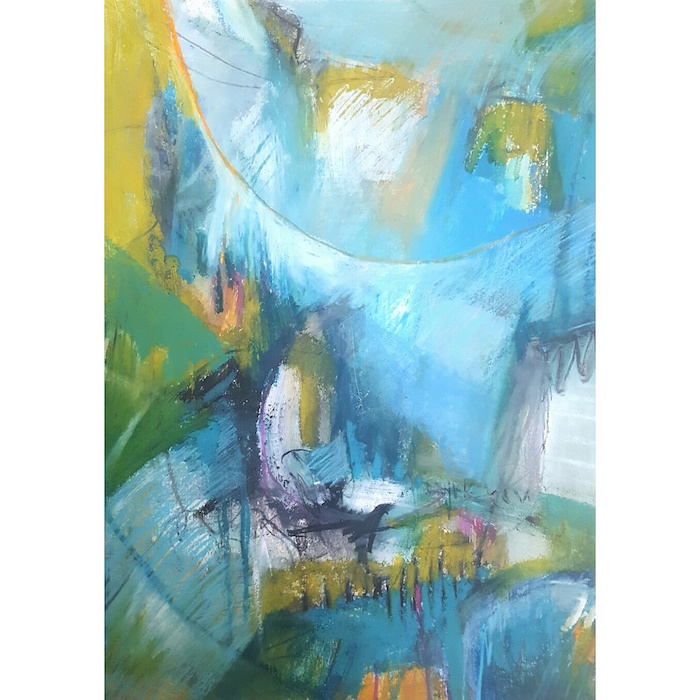
Here’s a painting with a strong diagonal composition, with lighter values in the top section, and darker, more ‘grounding’ values below
Keep turning it to check for balance
This is valid advice for any painting; the more you do it the easier it becomes to instantly see what’s out of balance.
Balance doesn’t mean everything’s equal or looking the same – that’s not interesting for the eye and ironically tends to mean it’s out of balance – it means that all the parts of the painting work together and within the frame of the four edges.
Check your edges!
Edges are just as important to the success of a painting as what you put inside them.
They can help to anchor the painting, create a pleasing imbalance, or suggest more going on ‘off stage’. Keep your eye on them as you paint and don’t let your focal point get lost floating in the centre.
See how in this one, a couple of the posts are coming in from the right, and on the left part of the grass is disappearing off the edge.
If I’d not had anything touching the edges it wouldn’t look right. {Try blocking them out with your fingers – you’ll see what I mean!}
Vary your marks
Marks are fascinating things.
They ‘talk’ to each other, so that every one you make contributes to the conversation.
It’s up to you to create a harmonious conversation, or even a disjointed one, but one that can be ‘read’ by the viewer, even though no two people will read it the same. {Art is full of paradox!}
I like to push myself to create as many different types of marks as I can while I’m working; it’s surprisingly hard because we fall into patterns and habits.
For example, I have a deep love and abiding habit of making vertical marks, so I have to be careful to balance that with more horizontals than I might think of making.
It’s so much fun to have that challenge running as I paint – it keeps me on my toes!
Here’s an experiment in mark making I made recently for the Touchstone course. No reference image, but that ‘path’ is showing up again! And quite a few verticals. 😊
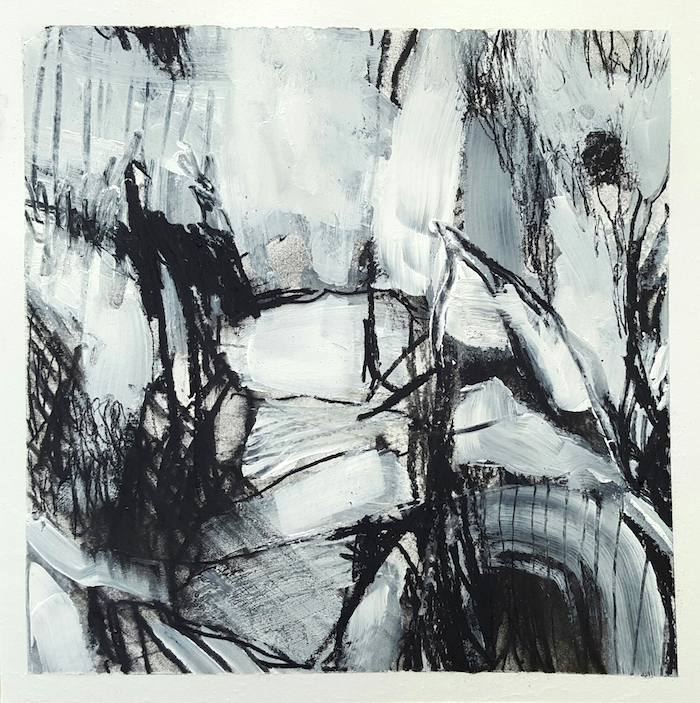
Use your feelings
Because abstract art doesn’t have a recognisable subject, the subject can become pure emotion.
I recently made a painting while drinking wine and dancing, and I was in the most fabulous mood while doing so. {Wine! Underrated art supply!}.
Here’s the painting that resulted:

It’s quite chaotic and I’ve since calmed it down a bit, but you can see and feel the exuberance I was feeling as I painted it.
So channel what you’re feeling and let it inform your painting! Obviously this can be very cathartic too.
Have a concept
Something I’ve been playing with a lot recently is the idea of painting ‘weather’.
To me that means not literally painting blue skies or rain, but the feeling that weather carries, in particular wind.
I’m not sure why – wind is my least favourite weather condition – but often when I’m painting I’ll find I’m thinking about the wind and what it ‘looks’ like. It helps keep the paintings dynamic and alive.
You might choose a less violent concept!
It doesn’t matter what it is, only that it inspires you and helps you stay focused.
Switching from one concept to another can lead to a confused and confusing painting.
Keep it simple {your approach, not necessarily the painting!}
As a basic rule of thumb, variation and contrast are what will help make the painting interesting, especially if you’re a bit of a noob and not feeling too confident about you’re doing!
Personally I prefer paintings with more darks and lights, and a feeling of dynamic movement.
Here’s a video of me making one of my ‘almost abstracts’ – Chaos Precedes Order, which I mentioned earlier in the post – from start to finish. I sped it up or we’d be here all day. 😊
“This video unstuck something in me. Yesterday I spent the happiest three hours painting than I have in a long time. I’m still unsure of the results but I feel freed up again, and enthused. And you know how tiresome it can be when your creativity dries up, so thank you so much for sharing that – it was very generous, I feel like I was given a gift!”
Vicki Hutchins
I hope this helps! I’m by no means an old hand at abstract painting, but I use and find every one of these points helpful, and I’m making some work I love {and others do too} lately.
Do you have any questions? If so, pop them in the comments and I’ll do my best to help. Or do you have any techniques that help you make abstracts? My list is by no means exhaustive so please do share your own experience!
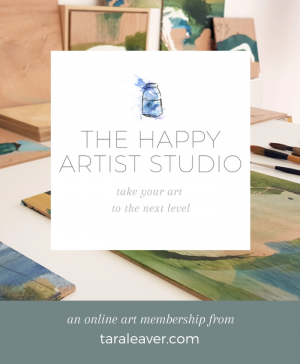 If you enjoyed this post and are all fired up to dig deeper into your own process and practice as an artist, you might like to check out the Happy Artist Studio.
If you enjoyed this post and are all fired up to dig deeper into your own process and practice as an artist, you might like to check out the Happy Artist Studio.
It contains 20+ courses and other resources I’ve created over the years, all focused on helping you make the art you’re here to make. Release the realism, the heavy influence of other artists, and start to build a true to you body of work, whether for your own pleasure, to move toward selling, or both.
Click here or the image on the left to find out more and join today!

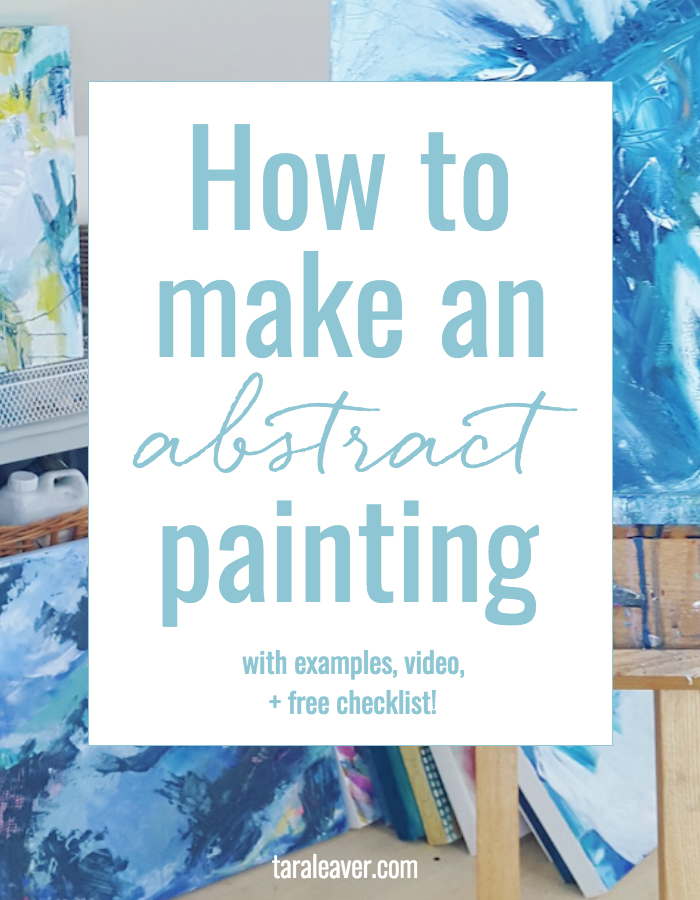
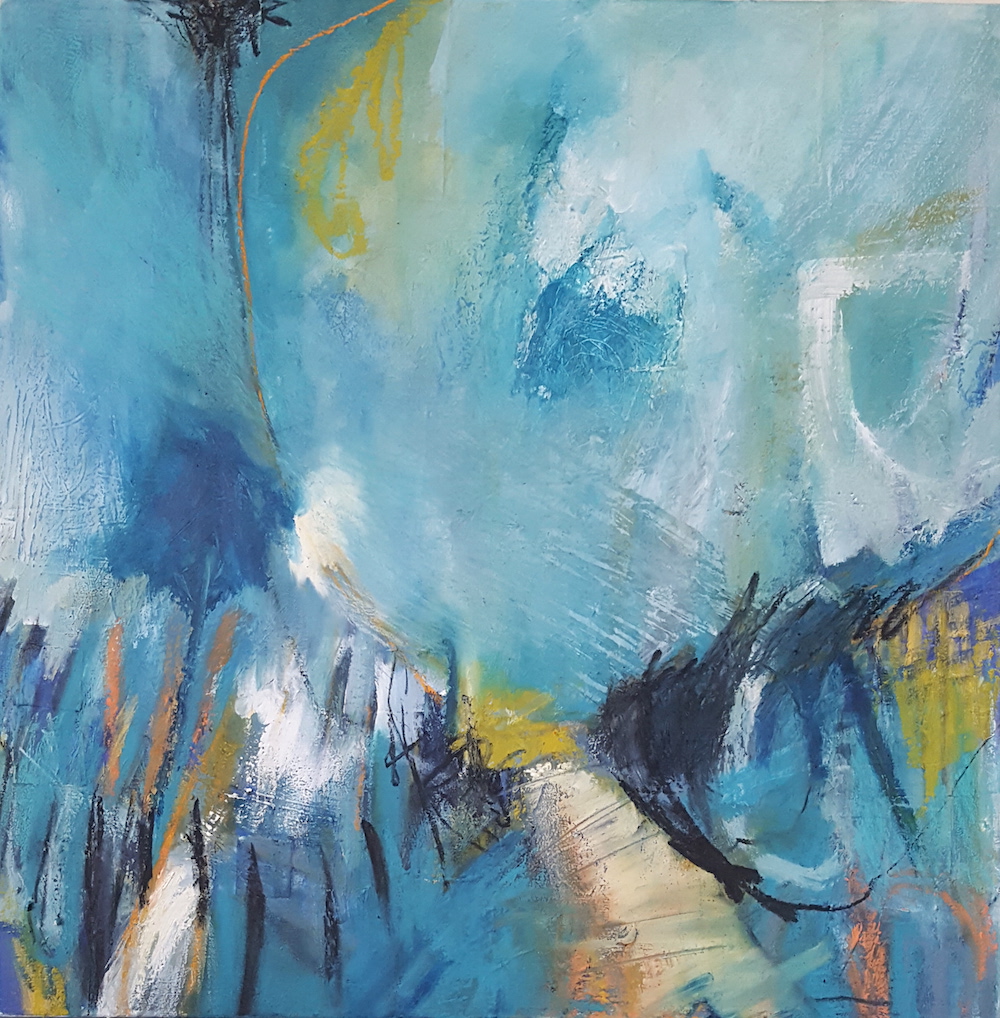
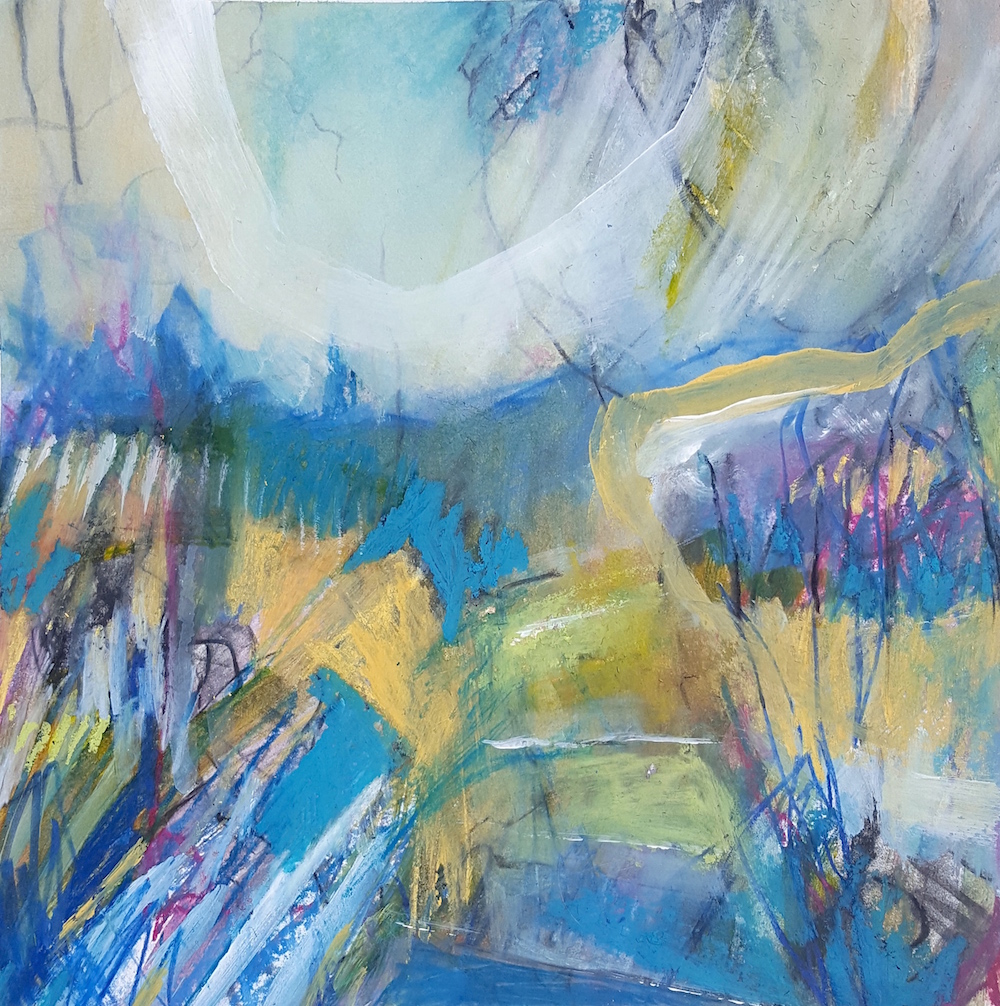







It’s always fascinating to see how other artist work. I really appreciate your time laps videos. Your process is almost the opposite of mine.
I start with no reference image or clue as to what I’ll paint. After making marks and playing around with colour I start seeing things on the canvas, which I “make more visible”. Sometimes it works, sometimes it doesn’t. So adding and removing is going on for a long while.
What I feel I want to take with me is how comfortable you are with making different marks. I really have to work on that. Even if my goal isn’t to become a fully abstract artist there are lessons to be learned here ????
That’s such a great point Gina – obviously everything I suggest is just that, a suggestion, but I forgot that some people work the opposite way around! In fact I’ve done that myself too, now I think about it! I don’t think I really choose how I do my paintings these days; your way makes a lot of sense to me but it’s not what happens! And yes, I’m constantly striving to expand my mark repertoire! It’s so easy to get stuck in ruts with the ones that come easiest.
Very motivating to get unstuck. Love the process and outcome.Peggie
Happy you found something helpful here Peggie!
Love Love????
Loved watching this demonstration. Your process is exhilarating and the colors were so pleasing to my eye. Thanks for sharing. I am a sponge when it comes to learning new techniques in making art. I am a fairly new artist but have created a few abstract pieces. I pulled one out today and began to tweak it a bit. Need to leave it be for a while before I change it. I then saw your video.
Thank you Margaret! So glad you enjoyed it.
I love the video! And these are great tips. I don’t paint much, but I’ve been craving getting back to my first love – collage. This makes me want to fake a migraine and leave work so I can go play at my art table!
Far be it from me to encourage skiving from work. 😉 Hope you still got to play!
Excellent tips and loved the video, by the time I get to the end I can barely remember the beginning. I used to begin with linear forms but with paint I now try and build up more solid areas of colour. Sometimes I deliberately use the opposite colours of what I think the painting may end up so there are interesting areas where the color breaks through, but that only works with more opaque paint rather than the mediums you are using. Great post, thanks.
Love to hear about these different approaches! And that idea of using opposite colours – thanks for sharing!
I too have a natural lean towards vertical marks. For one of my recent pure abstracts I deliberately painted circles…. but by the end they’re nowhere to be seen! But I kind of think they did influence the overall painting. Or perhaps because I knew they were there.
Loved this post Tara, and especially appreciated seeing your process on video! I also really like that monochromatic piece. Fab.
Isn’t funny how it just takes over even when you try to intervene! Thanks for the kind words Vicki! Seems the video is quite popular; will have to do more of those. 🙂
Thanks for the video on abstract painting tips. Everything you mention is everything I struggle with when it comes to painting abstract. Looking forward to one of your classes soon. You are truly an inspiration!!!
You’re most welcome Deborah! Glad it was useful to you!
I also work fast. Using similar materials. However, I often use antelope brown acrylic ink first. I make marks with a bamboo stick or twig, etc.That gets me going.I think your idea of using a word is helpful..I like rain.
That’s an idea. Remember the blind contour drawing?
That helped as a starting point for going on with colors also.
What was your white?
Thanks for sharing your process and ideas. Sally
Hi Sally – I love that idea of using a twig and ink! I had a phase of using ink and seagull feathers I picked up around here. My white is always gesso. Thank you for stopping by!
What products are u using. I’m painting in oil but want to use a black or white writing “pen”. That I can get a thin line. ???
Loved seeing the video great!
Hi Phyllis, in the video I use charcoal {both willow and compressed}, Neocolors, Inktense blocks with water, oil bars, gesso and even some paint as well. 🙂 I’m not familiar with writing over oils, but I imagine you might need something that would ‘stick’, so something waxy like a Chinagraph pencil which can be sharpened to a fine point. Over acrylics I’ve used Sharpies and a Uni posca pen in white. Hope that helps!
Wonderful! I always enjoy seeing time lapses. Thank you for the muddy comment 🙂 that has been my obstacle, but this video helped me to remember that it’s a process and to keep going! Love your use of various mediums… Beautiful work, thank you for sharing!
Glad it was helpful to you Megan!
Thank you so much for sharing your advice, time & skills with us. I can really relate to you when you said you didn’t ‘get’ abstract art, that was exactly me. I’ve only just recently begun practicing abstract as it’s just unexplainably drawn me in. All your points are so helpful, I’m going to add them to my journal as a sort of ‘checklist’ each time I create a new piece. You’ve inspired me to find some courses too. Thanks so much, I really enjoyed your video as well.
I’m so glad to hear it’s helping you Elisha! It’s funny how these things sneak up on you isn’t it!
Hi Tara,
I just discovered you and your blog. What a lucky discovery for me! I’m a “born again” art explorer. Your “art”icles have come at the best time for me! I have spent the last two years trying on examples of other artists styles all the while trying to re-aquaint myself with supplies and techniques. The collective work is rather disjointed. I have loved exploring but I’m ready to go in my own direction (not an easy thing).
Anyway, I just wanted to say that you are right on the button with your words of encouragement and I feel very lucky to have stumbled upon you!
‘Art’icles! That made me laugh. So glad to hear it’s helpful to you Kimn! I love the term ‘art explorer’ too. I spent years making disjointed work {and still do at times}, but it does start to come together the more you do.
How do you seal your mixed media paintings and prepare them for archival purposes?
Hi Donna – I use fixative spray to seal the charcoal areas – a few light mistings from about arm’s length away.
What type of paper do you prefer and do you start with the paper dry, wet or with gesso? Loved your process video. Thanks!
I use an acrylic tear off pad by Seawhite – super thick and sturdy! And I just go straight in, I don’t wet the paper or apply gesso to prepare it. Hope that helps!
Tara, I’m not finding the lime green Oilbar? What is the brand and color name? Perhaps it’s not jumping out at me on the internet listings.
Love! Love! Love! This video, your process, your style! Truly inspiring!
My intense blocks I just ordered are in their way!
The oil bars, I’m working on. :).
Much love, E
Hi Ellen – it’s by Sennelier, but unfortunately mine is so well loved I can’t see what the colour is called! It’s just a very light, limey green. Thank you for the kind words. 🙂
After realizing I almost always become more excited about what I see on my palette than what I see on my canvas, I realize I’m an abstract artist.
Love that. 🙂
Enjoyed the video, but I also really liked the music. Can you tell me the name of the piece/composer?
Thanks!
Barbara
It’s royalty free music called Perspectives by Kevin McLeod at incompetech.com.
So inspiring!Enjoy yr video and learn sth on it. What tape u use to stick on the board? It didnt hurt the paper at all!????
It’s by Cantech – low tack masking tape. 🙂
What a JOY to find you and your work. I’m over 70 and reborn into art.
Your video is excellent and SO helpful. Thank you.
Ah thank you Beata! I’m delighted to hear that.
Inspiring!!! Have never tried abstract, but cant wait to give it a try. Love your work Tara.
So happy you found something helpful here Dianne!
Gosh I have a hard time with abstract. I find it difficult. I am scared my painting would look like grade 3 student slapped some paint on a canvas and called it art. I am so glad for your honesty. Beautiful painting. Loved seeing the process. Must try again thank you. Picture in mind when you start is a process I can relate too!!
I think that’s a pretty common fear Katherine. 🙂 There’s something very mysterious about abstract, but it’s only by trying it that we can start to unravel its secrets!
I am a new at acrylic painting and I always seem to use to much black, I love abstract art but I always feel so discouraged after I am finished with my paintings, any suggestions or tips would be so very helpful.
Thank You
I’d suggest cutting out black altogether for a while. It’s hard to use effectively when you’re just starting out, and it’s also easy to make more interesting darks by mixing other darks together, such as Paynes Gray and Van Dyke Brown or Burnt Sienna. Consider your values – where are the lights and darks and are they leading the eye around the page? And here are two posts on composition – play with a few and see what feels good and how they work:
https://taraleaver.com/2015/02/3-easy-ways-to-create-interesting-compositions/
https://taraleaver.com/2017/05/3-ways-create-interesting-compositions/
Hi Tara, your site and the video really inspired me! Having always done water colour and pastel. I wanted to try abstract acrylic. But each time it ended up looking like a realistic painting and I was also having trouble blending. I just didn’t know where to start and end up painting white over the canvas each time I start something.This has really helped and inspired me to really just try a new way and free up. I bought the blocks and crayons and love those too. Thanks so much for help getting me going on my new abstract journey. Please do more time lapse too XX
Belinda I’m delighted you found something inspiring and helpful here! It’s such a common stumbling block to want to make abstract work as someone who’s always done more realistic art and find that you keep sliding back into realism. I’ve found it really is a case of just continuing to experiment and find ways to loosen it all up, especially all those outlines. Turning the painting while you work helps with this as well.
Great video one can see the freedom with which you paint, and I feel that abstract art needs that freedom cause only then a free mind and heart can work together.
Really enjoyed seeing your process, especially as I am a beginner and losing the fluidity and dynamism of my charcoal, Conte-crayon and soft pastel drawings when I try to use them as references for my paintings.. I would like to start like you did here, so please, can you tell us what mediums you were using after the charcoal? I’d be worried of creating mud.
I hope you have given up on using baby wipes/wet-wipes – they are so bad for the environment and we can manage very well without them! I do worry about the environmental impact of so many of the materials I use.
Glad you enjoyed it Jacqueline! I was using compressed charcoal, Inktense blocks and water. Compressed is better for reducing muddiness and retaining some darks. I don’t mind a bit of mud, but you could also use a matt spray varnish or fixative to isolate layers. Like you I’m trying to be more mindful about the environment – the work I make now doesn’t involve baby wipes, although more natural, biodegradable ones are coming on the market.
Thank you, Tara, there’s so much inspiration here on your site. I’ll go get some Inktense blocks now!
In your lovely painting Chaos precedes order – what surface were you working on? I thought paper – but it must have been very strong, and then when you removed it, I thought maybe some sort of board. I found it v exciting to see how many different media you used – inktense blocks, gesso, oil blocks, etc. Thank you
It is paper! Most likely from the Seawhite Acrylic paper tear off pad. I also sometimes use watercolour paper. Both can withstand a lot of enthusiasm! Glad you enjoyed it. 🙂
Do you ever create your abstract pieces on canvases? I really enjoyed watching your process. Thank you!
I do! I like to use different substrates because they all behave and respond differently.
Hi
I really enjoyed your demonstration. As an artist who struggled to turn abstract, I found using HUGE brushes and a limited palette the best approach. Because you don’t necessarily want detail, the huge brushes, even house paint size, stops you from fiddling with detail. The limited palette will create a natural colour harmony, and to keep it fresh, avoid black, to darken tones, I find it good for limited detail and contrasting marks. White or black can really deaden a vibrant painting. Also try a HUGE canvas to loosen up.
All great tips! Agree about black and white potentially deadening a painting.
I am using oil, Acrylic or pastels. I want to start with Abtract paintings, but I am so used to do detailed work. I will try my best and I am sure I am going to enjoy it.
I enjoy your comments. You sound very positive. It was good to see comments from many other artists, also.
I know that I can learn a lot more from you and from all other artists.
The transition from detailed to more expressive can take a little time, but so worth it for the freedom!
Hard to tell from a time lapsed video, but do you let the painting dry in between or is done in one foul swoop pls? It appears to be the latter because of the blurred effect bu tI may be wrong…
I work in acrylics so it dries pretty quickly. If an area is particularly wet and I don’t want to work into it I’ll let it dry a bit or use a hairdryer!
Tara:
I have been painting for a few years and my subjects have always been “something” – a face, an animal, a scene, etc. Lately, I have been looking at abstract paintings and they do not look like anything except a bunch of different colors and/or lines. In fact, they look like a three-year old has painted them. Am I just old fashioned or is there a way to make an abstract painting of that “something”?
Hi Sean – great question! And kind of a big one. 🙂 There are so many ways to make abstract work, and in many ways it’s a mindset shift from ‘something’ to ‘apparently nothing’. There are also degrees of abstract – lots of artists, myself included, mix the abstract with the recognisable. Typically abstract comes from a more direct emotional/conceptual place than figurative work {although not always} – it’s about FEELING something when you create and/or look at it. The way I see it, it’s an expression of something that doesn’t have or require words or specific images. A good way I think is to start exploring both what abstract artists have said about their work {try Helen Frankenthaler or Joan Mitchell or Agnes Martin}, and to start playing around with how you might express your own feelings in a more direct way – what kind of marks you’d make, the palette you’d choose, would it be 3d/2D etc.
Tara I have had such fun this afternoon thanks to you. Painted a very loose still life with big brushes and swiping tools and did it on paper so I didn’t feel pressure to make a “proper” painting. You are a very generous person to share so many tips with us and you present them in a doable way. Very glad to have discovered you. Thank you!
Susan that’s wonderful, so pleased you found it helpful! Thanks for taking the time to come back and leave a comment!
Like to learn to paint abstracts more with acrylic paints.